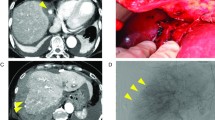Abstract
Endoscopic sphincterotomy (ES) is a standard procedure for bile duct stone removal. However, the safety of ES in patients with hemophilia remains unknown. We treated a 46-year-old man who had choledocholithiasis and severe hemophilia A with high-responding inhibitors during immune tolerance induction therapy. Since coagulation factor VIII inhibitors neutralize and inactivate endogenous and exogenous factor VIII, bleeding risk is higher in hemophilia A patients with inhibitors than in those without inhibitors. With adequate pre- and post-procedure monitoring of the clotting factor and supplemented clotting factor, the patient could safely undergo ES without bleeding complications. ES can be also an effective and safe first-line therapy for choledocholithiasis in patients with hemophilia and inhibitors under the condition of appropriate management.





Similar content being viewed by others
References
Aliperti G. Complications related to diagnostic and therapeutic endoscopic retrograde cholangiopancreatography. Gastrointest Endosc Clin N Am. 1996;6(2):379–407 Epub 1996/04/01.
Cotton PB, Lehman G, Vennes J, et al. Endoscopic sphincterotomy complications and their management: an attempt at consensus. Gastrointest Endosc. 1991;37(3):383–93 Epub 1991/05/01.
Katsinelos P, Pilpilidis I, Paroutoglou G, et al. Endoscopic sphincterotomy in adult hemophiliac patients with choledocholithiasis. Gastrointest Endosc. 2003;58(5):788–91 Epub 2003/11/05.
Fujita N, Maguchi H, Komatsu Y, et al. Endoscopic sphincterotomy and endoscopic papillary balloon dilatation for bile duct stones: a prospective randomized controlled multicenter trial. Gastrointest Endosc. 2003;57(2):151–5 Epub 2003/01/31.
Disario JA, Freeman ML, Bjorkman DJ, et al. Endoscopic balloon dilation compared with sphincterotomy for extraction of bile duct stones. Gastroenterology. 2004;127(5):1291–9 Epub 2004/11/03.
Watanabe H, Yoneda M, Tominaga K, et al. Comparison between endoscopic papillary balloon dilatation and endoscopic sphincterotomy for the treatment of common bile duct stones. J Gastroenterol. 2007;42(1):56–62 Epub 2007/02/27.
Sakai M, Taki M, Ieko M, et al. Hemostatic treatment guidelines forinhibitorspossess congenital hemophilia patients. Jpn J Thromb Hemost. 2013;24(6):640–58.
Kasper CK. Diagnosis and management of inhibitors to factor VIII and IX. World Fed Hemoph. 2004;1:22
Tiede A. Half-life extended factor VIII for the treatment of hemophilia A. J Thromb Haemost. 2015;13(Suppl 1):S176–9 Epub 2015/07/08.
Katsinelos P, Kountouras J, Chatzimavroudis G, et al. A novel technique of injection treatment for endoscopic sphincterotomy-induced hemorrhage. Endoscopy. 2007;39(7):631–6 Epub 2007/07/06.
Eisen GM, Baron TH, Dominitz JA, et al. Guideline on the management of anticoagulation and antiplatelet therapy for endoscopic procedures. Gastrointest Endosc. 2002;55(7):775–9 Epub 2002/05/25.
Van Os EC, Kamath PS, Gostout CJ, et al. Gastroenterological procedures among patients with disorders of hemostasis: evaluation and management recommendations. Gastrointest Endosc. 1999;50(4):536–43 Epub 1999/09/29.
Scharrer I, Bray GL, Neutzling O. Incidence of inhibitors in haemophilia A patients–a review of recent studies of recombinant and plasma-derived factor VIII concentrates. Haemophilia Off J World Fed Hemophilia. 1999;5(3):145–54 Epub 1999/08/12.
Dimichele D. Immune tolerance therapy for factor VIII inhibitors: moving from empiricism to an evidence-based approach. J Thromb Haemost. 2007;5(Suppl 1):143–50 Epub 2007/08/01.
White GC, Rosendaal F, Aledort LM, et al. Definitions in hemophilia. Recommendation of the scientific subcommittee on factor VIII and factor IX of the scientific and standardization committee of the International Society on Thrombosis and Haemostasis. Thromb Haemost. 2002;85(3):560 (Epub 2001/04/20).
Acharya SS, DiMichele DM. Management of factor VIII inhibitors. Best Pract Res Clin Haematol. 2006;19(1):51–66 Epub 2005/12/27.
Kawabe T, Komatsu Y, Tada M, et al. Endoscopic papillary balloon dilation in cirrhotic patients: removal of common bile duct stones without sphincterotomy. Endoscopy. 1996;28(8):694–8 Epub 1996/10/01.
Sasahira N, Tada M, Yoshida H, et al. Extrahepatic biliary obstruction after percutaneous tumour ablation for hepatocellular carcinoma: aetiology and successful treatment with endoscopic papillary balloon dilatation. Gut. 2005;54(5):698–702 Epub 2005/04/16.
Takahara N, Isayama H, Sasaki T, et al. Endoscopic papillary balloon dilation for bile duct stones in patients on hemodialysis. J Gastroenterol. 2012;47(8):918–23 Epub 2012/02/23.
Author information
Authors and Affiliations
Corresponding author
Ethics declarations
Conflict of interest
Drs. Sugiura, Kuwatani, Kawakubo, Sano, Kato, Endo and Sakamoto declare that they have no conflict of interest.
Human/animal rights
All procedures followed have been performed in accordance with the ethical standards laid down in the 1964 Declaration of Helsinki and its later amendments.
Informed consent
Informed consent was obtained from the patient for being included in the study.
Rights and permissions
About this article
Cite this article
Sugiura, R., Kuwatani, M., Kawakubo, K. et al. Successful endoscopic sphincterotomy for choledocholithiasis in a patient with severe hemophilia A and inhibitors. Clin J Gastroenterol 11, 188–192 (2018). https://doi.org/10.1007/s12328-018-0826-8
Received:
Accepted:
Published:
Issue Date:
DOI: https://doi.org/10.1007/s12328-018-0826-8




